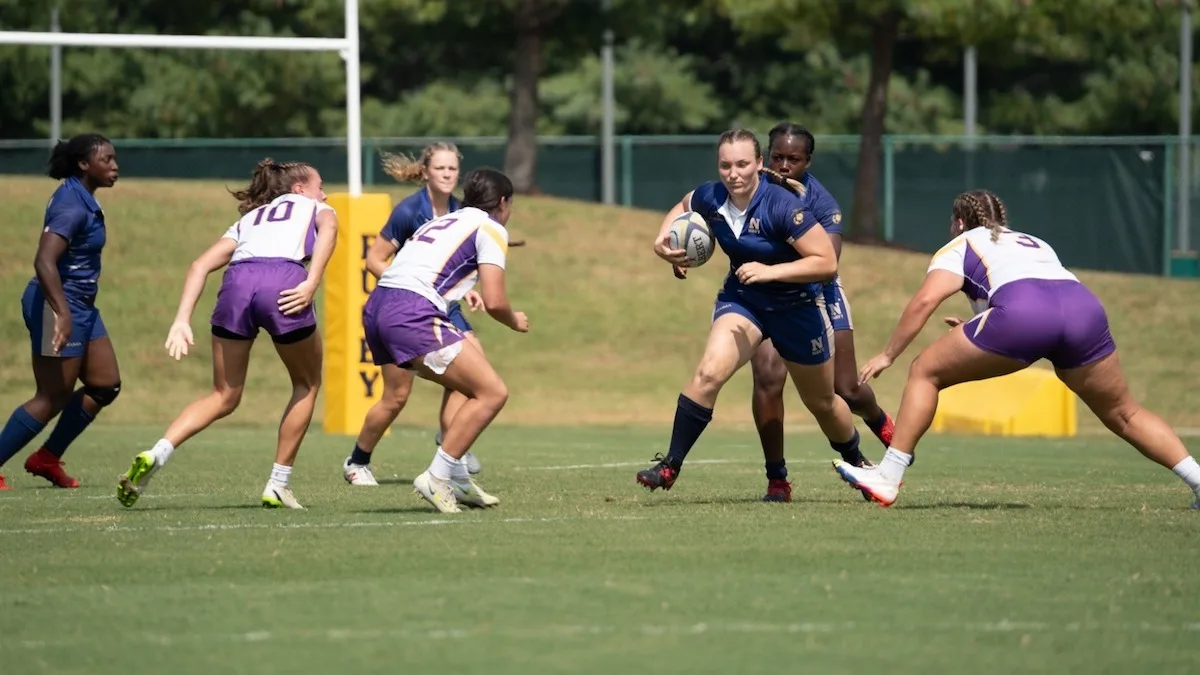Introduction
Rugby, a high-octane collision sport, showcases a symphony of physicality, skill, and strategy. While tries and conversions captivate spectators, a rugby team’s ability to defend its try line is equally enthralling. Organizing an effective defensive line is a ballet of precision and teamwork that prevents opponents from crossing the try line and scoring. In this comprehensive article, we will dissect the intricacies of how rugby teams organize their defensive lines, focusing on key elements, strategies, and positional play that make it all possible.
The Anatomy of a Rugby Defensive Line
1. Formation and Structure
A well-organized rugby defensive line is like a fortress guarding its citadel. It begins with the formation and structure. Teams typically employ two primary defensive formations: the flat line and the staggered line.
1.1 Flat Line
The flat line defensive formation involves defenders forming a straight line parallel to the gain line. This approach puts pressure on the attacking team, leaving minimal gaps for exploitation. It requires cohesion and synchronized movement among defenders to maintain its integrity.
1.2 Staggered Line
In contrast, the staggered line defensive formation features defenders positioned slightly behind each other, creating an angled defensive wall. This approach aims to cut off attacking angles, making it harder for the opposition to break through.
2. Spacing and Communication
Spacing within the defensive line is crucial. Defenders must maintain consistent intervals between themselves to prevent attackers from exploiting gaps. Effective communication is the adhesive that holds the defensive line together. Players often use verbal cues, such as calls for “drift” or “hold the line,” to ensure everyone moves in unison.
3. Positional Play
The success of a rugby defensive line relies heavily on the understanding of individual roles and positional play. Let’s delve into the key positions and their responsibilities:
3.1 Fullback
The fullback is the last line of defense, positioned behind the defensive line. Their primary responsibility is to catch high balls, cover kicks, and make try-saving tackles. A reliable fullback can be a game-changer in defense.
3.2 Wingers
Wingers are often stationed on the edges of the defensive line. They must possess speed and agility to cover their channels effectively. Wingers play a crucial role in preventing opponents from exploiting the flanks.
3.3 Centers
Centers are positioned near the midfield and are versatile defenders. They need to be skilled in tackling, reading the attacking play, and disrupting the opposition’s passing lanes.
3.4 Halfbacks
Halfbacks, usually the scrum-half and fly-half, play an essential role in organizing the defensive line. They communicate with forwards and backs to ensure a coordinated effort. Their quick decision-making is vital in defensive alignments.
3.5 Forwards
Forwards form the core of the defensive line, and their roles vary depending on the phase of play. In scrums and lineouts, they engage in physical battles to regain possession. In open play, they provide relentless tackles and ruck support to slow down the opposition.
4. Defensive Patterns and Systems
Rugby teams employ various defensive patterns and systems to counter specific threats posed by the opposition. These patterns are like chess moves, designed to anticipate and neutralize the attacking strategies of the opposition.
4.1 Rush Defense
The rush defense is an aggressive approach where defenders move forward rapidly to close down space and put pressure on the ball carrier. It’s effective in forcing turnovers but requires exceptional timing and discipline.
4.2 Drift Defense
Drift defense involves defenders moving laterally to cover space and create a wall that pushes attackers towards the touchline. It’s an excellent strategy for denying the opposition space to exploit.
4.3 Blitz Defense
Blitz defense is all about controlled aggression. Defenders rush forward to disrupt the attacking flow and make tackles behind the gain line. It can be high-risk, high-reward and requires split-second decision-making.
4.4 Umbrella Defense
Umbrella defense combines elements of both rush and drift defenses. It starts with a rush to pressure the attackers and transitions into a drift to cover wide spaces. It’s adaptable and used when the attacking threat is varied.
Key Defensive Strategies
1. Line Speed
Line speed, the rapid movement of the defensive line forward, is a critical component of effective rugby defense. It reduces the time available to attackers, forcing them into rushed decisions and errors. Maintaining synchronized line speed is a formidable challenge that requires precise timing and teamwork.
2. Counter-Rucking
Counter-rucking is a technique employed by forwards to disrupt the opposition’s possession at the breakdown. It involves driving into the ruck with intensity to force turnovers or slow down the release of the ball. Effective counter-rucking can stifle an opponent’s attacking momentum.
3. Dominant Tackling
Tackling is the backbone of rugby defense. Dominant tackles are those that stop the ball carrier’s progress and often result in turnovers. Key aspects of dominant tackling include technique, timing, and the ability to target the ball or strip it from the attacker.
4. Defensive Kicking
Defensive kicking is a strategic weapon in rugby defense. Teams use kicks to relieve pressure, gain territory, or force the opposition into making mistakes. The fullback and fly-half often play pivotal roles in executing well-placed kicks.
5. Kick Chase
After a kick, the kick-chase is a collective effort to put pressure on the receiving team. Players sprint down the field to contest possession, aiming to tackle the receiver as soon as they catch the ball. A successful kick chase can lead to turnovers or territorial gains.
The Evolution of Defensive Strategies
Rugby’s defensive strategies have evolved over the years, adapting to rule changes, player athleticism, and coaching innovations. Here are some notable shifts in defensive thinking:
1. Professionalization of Coaching
The advent of professional rugby brought a new level of coaching expertise. Coaches now analyze data, employ video analysis, and use sports science to fine-tune defensive systems. The fusion of technology and rugby IQ has led to more sophisticated defensive structures.
2. Defensive Specialization
Teams now have specialized defensive coaches who focus exclusively on defensive strategies. These experts work on improving individual and team defensive skills, ensuring that every player contributes effectively to the defensive effort.
3. Defensive Patterns
Modern rugby places a strong emphasis on defensive patterns and systems. Teams study their opponents meticulously, identifying attacking trends and vulnerabilities to create tailored defensive plans.
4. Fitness and Conditioning
A significant shift in defensive play is the emphasis on fitness and conditioning. Players are now fitter, faster, and more agile, enabling them to cover ground quickly and make multiple tackles in a short span.
The Psychological Aspect
Defense in rugby is not just a physical endeavor; it’s a psychological battle as well. The mental resilience of a team plays a significant role in its defensive success. Here’s how the mental aspect influences rugby defense:
1. Team Cohesion
Trust and cohesion within the team are vital for an effective defensive line. Players must have faith in their teammates to make tackles, cover gaps, and execute the defensive plan. This trust is built through training, shared experiences, and communication.
2. Decision-Making Under Pressure
Rugby is a fast-paced game with split-second decisions required in defense. Players must remain calm under pressure, read the game, and make the right choices. Mental toughness and discipline are invaluable traits for rugby defenders.
3. Defensive Mindset
A strong defensive mindset is essential for rugby success. Players must embrace the idea of defending their try line as if it were their last stand. The psychological aspect drives the physical commitment required to make tackles and turnovers.
Case Studies: Legendary Defenses
Let’s examine some legendary rugby defenses that have left an indelible mark on the sport’s history.
1. The 2003 England Rugby World Cup-winning Team
The 2003 England team, under the leadership of Clive Woodward, displayed a remarkable defensive prowess throughout the Rugby World Cup. Their ability to absorb pressure, maintain discipline, and execute dominant tackles were instrumental in their triumph.
2. The New Zealand All Blacks
The New Zealand All Blacks have consistently been one of the world’s best defensive teams. Their defensive patterns, communication, and the ability to turn defense into attack have set a benchmark for excellence.
3. The South African Springboks
The South African Springboks, known for their physicality and tenacity, showcased an exceptional defensive performance in their 2019 Rugby World Cup victory. Their rush defense, ferocious tackling, and tactical kicking were key elements of their triumph.
Conclusion
In the unforgiving arena of rugby, a strong defensive line is the ultimate shield. It requires meticulous planning, unwavering teamwork, and a blend of physical and mental prowess. The evolution of defensive strategies, specialized coaching, and the ever-increasing athleticism of players have elevated rugby defense to an art form. As we celebrate the brilliance of attacking tries, let us not forget the unsung heroes who stand resolute in defense, preventing opponents from scoring and showcasing the true essence of rugby’s strategic intricacies.

